By Valerie Milano
Boyle Heights, CA (The Hollywood Times) 6/12/24 – Sunday was the closing night of the play “Frida: Stroke of Passion” at Boyle Heights’ CASA 0101 Theatre. Running for a month since May 5th, “Frida: Stroke of Passion” is an original play written, acted, and produced by Odalys Nanin. Featuring iconic Mexican songs and integrating visual projections of some of her most famous paintings, this play is billed as “interactive” with a focus on Frida Kahlo in the waning years of her life before she died in 1954. Directed by Corky Dominguez, “Frida: Stroke of Passion” is a revival of the play that premiered at Macha theater venue in WeHo in 2017, this time with the addition of her paintings projected onto the theatre walls.
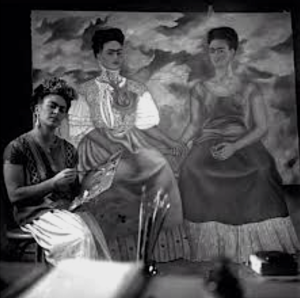
Many actresses have taken on the role of Frida Kahlo on stage and in films. Odalys Nanin presents us with a feisty older Frida who knows all too well the pain her wrecked body feels, especially after the amputation that removed her right leg below the knee. Struggling with crutches and a wheelchair, she tries to muster the energy to get out of bed and return to her easel to paint. She is haunted by memories of former lovers and the ghostly presence of others – some real people and other creatures of her imagination. She is even visited by the wounded deer Judas (Alex Honorato) who prances through her bedroom right out of her painting “The Wounded Deer.”
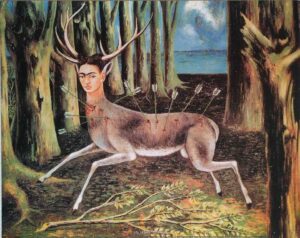
“Frida: Stroke of Passion” is one interpretation of the life of the famous Mexican painter who was married to muralist Diego Rivera. As the playwright Odalys Nanin recounts the history of her play: “I wrote this play and it premiered September 2017 at my old venue that used to be located at 1107 N. Kings Road, West Hollywood. I was there for 11 years. . . . We were not able to produce again till February 2019 at CASA 0101 theater. In 2019 & 2020, I produced Frida – Stroke of Passion at CASA 0101 – each time to sold out houses. This was pre-pandemic times. Theaters went dark in 2020 so I produced two short films and one documentary. In 2021, I produced at CASA 0101 my play The Nun & The Countess and in 2023, I produced my other famous play “Garbo’s Cuban Lover.”
Frida Kahlo was born Magdalena Carmen Frida Kahlo y Calderón on July 6, 1907, in the house of her parents, known as La Casa Azul (The Blue House), in Coyoacan, a suburb of Mexico City. Kahlo’s mother, Matilde Calderon y Gonzalez, was of mixed Spanish and indigenous ancestry, while her father Guillermo Kahlo Kauffmann was German of Hungarian descent. Frida always claimed to be born in 1910, the year the Mexican revolution began, so that people would directly associate her with modern Mexico.
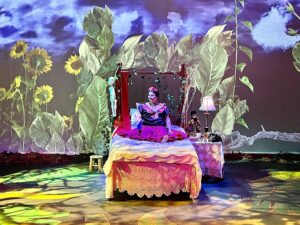
This detail introduces us well to her unique personality, characterized since childhood, by a deep sense of independence and rebellion against ordinary social and moral habits. Moved by passion and sensuality, Frida was very proud of her “Mexicanidad” and cultural traditions set against the reigning Americanization: everything mixed with a peculiar sense of humor.

Her life was marked by physical suffering, starting with polio contracted at the age of five and worsen by her life-altering event occurring in 1925. A bus accident caused severe injuries to her body owing to a pole which pierced her from stomach to pelvis. The medicine of her time tortured her body with surgical operations (32 throughout her life), corsets of different kinds and mechanical “stretching” systems. Many of her works were painted while lying in bed. Drawing on personal experiences, her miscarriages, and her numerous operations, Kahlo’s works are often characterized by portrayals of pain. Of her 143 paintings, 55 are self-portraits which often incorporate symbolic portrayals of physical and psychological wounds.
The play opens with a guitarist and singer visiting Kahlo as she lays in her bed suffering with pain and attended to by her nurse Judith (Tricia Cruz). The singer is Chavela Vargas (played here by Gabriella Ortiz) born in Costa Rica but ended up in Mexico in the 1930s as a teenager. There, dressed as a man, she found fame performing traditional “ranchera” songs. Years after Kahlo’s death, Vargas publicly acknowledged her sexual identity as a lesbian and began talking about her long-ago love affair with Kahlo. According to Vargas, after meeting Kahlo at a party at Casa Azul she went on to live with the artist. During their time together Vargas would often sing to Kahlo as she painted – as we see at the start of the play. Photos document how close she was to Frida and, in the end, Vargas was reportedly at Kahlo’s bedside at death.
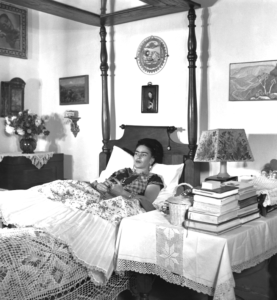
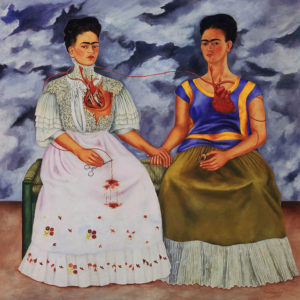
As a young artist, Kahlo met the famous Mexican painter, Diego Rivera (embodied here by actor Oscar Basulto), who recognized her talent. Diego saw her tremendous expression as truly special and uniquely Mexican. He encouraged her development as an artist and soon began an intimate relationship with Frida. They were married in 1929, despite the disapproval of Frida’s mother, divorced and then remarried in 1940. Their union was certainly not a usual one: Diego’s several affairs, including one with Frida’s sister Cristina, greatly upset her. In response to this betrayal by her family, Kahlo shaved off the majority of her signature long dark hair.
On the other hand, she also had a lot of lovers, both men and women, including Russian Revolutionary Leon Trotsky and Jacqueline Lamba wife of surrealist painter André Breton. The Bretons visited Mexico in 1938 and there met Diego Rivera and Frida Kahlo. Breton greatly admired Kahlo’s work. He several exhibitions for her paintings and also included some of her paintings in Paris at a surrealist exhibition in 1939, even though Kahlo did not like that association with Surrealism. Breton and his wife escaped Nazi-occupied France during World War II and ended up living in Mexico for a number of years.
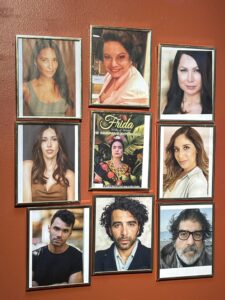
Kahlo’s husband, Diego Rivera – who wasn’t faithful himself – encouraged his bisexual wife’s romantic relationships with women. He did, however, get jealous of her male lovers, but Kahlo didn’t let his objections stand in her way. Over the course of her life, multiple famous men and women became her romantic partners. In January 1937, Kahlo greeted Leon and his wife when they arrived in Mexico seeking political asylum. Rivera and Kahlo also gave the Trotsky’s a place to live: Casa Azul, Kahlo’s childhood home. After all, Diego Rivera was a member of the Communist Party and both he and Frida believed in Revolution.
As the exiles settled in, Kahlo and Trotsky began an affair. One vengeful impetus on Kahlo’s part may have been Rivera’s affair with her sister. But Trotsky was a willing participant (he slipped notes for Kahlo into books in front of his wife). The two lovers communicated in English; a language Trotsky’s wife didn’t speak. Some of their assignations took place at the home of Kahlo’s sister (the same one who’d slept with Kahlo’s husband). The ghost of Leon Trotsky appears in this stage play (his voice provided by Paul Cascante) – continuing to haunt Frida. In 1939 after the murder of Trotsky, Rivera began divorce proceedings (though they would remarry after their divorce). The break-up may have inspired Kahlo’s 1940 Self-Portrait with Thorn Necklace and Hummingbird, a painting that depicts her pain and suffering.
Actress Dolores del Rio, one of the first Latin American stars in Hollywood, was friends with both Kahlo and Rivera. Though the actress has been counted among Rivera’s lovers, this didn’t prevent her from getting close to Kahlo as well – the artist had a history of befriending and charming her husband’s girlfriends. Throughout her life, del Rio was followed by gossip about affairs with men and women, the painting, Two Nudes in the Jungle, fueled speculation about the nature of her relationship with Kahlo. In 1939, Kahlo presented del Rio with a painting that, given its subject matter, demonstrates they had a very close relationship indeed. The gift, Two Nudes in the Jungle, depicts two naked women. We see the fairer of the two, resting on the other’s lap, slightly resembles del Rio – as the painting is projected on the stage’s back wall.
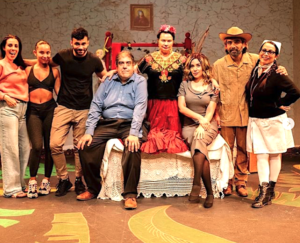
In this play, American-born photographer Tina Modotti (Corina Vela) appears as a character who was romantically linked to Diego Rivera. Modotti may also have helped foster the reunion between Rivera and Kahlo, as Kahlo likely re-encountered Rivera at one of Modotti’s parties back in 1931, long after Modotti had documented the Mexican Revolution with her camera and established herself as a famous photographer. As, with several of her husband’s lovers, Kahlo managed to maintain a friendship with Modotti.
Actress Paulette Goddard, whose husbands included Charlie Chaplin, was the star of movies Modern Times (1936) and The Diary of a Chambermaid (1946). Like Dolores del Rio, she’s been romantically linked to Rivera – and, according to some rumors, to Kahlo as well. In August 1940, Trotsky was murdered. Rivera came under suspicion he and Trotsky had fallen out favor, possibly because Rivera had learned of Kahlo’s affair with the exiled Trotsky. Fortunately, Goddard helped Rivera elude the Mexican police and enter the United States.
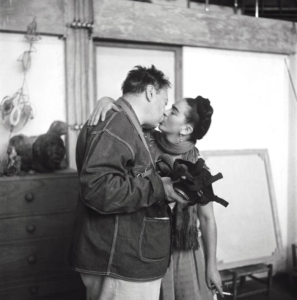
Some of Kahlo’s lovers are not mentioned in this play include the Japanese American sculptor Isamu Noguchi. Kahlo and Noguchi became lovers in the mid-1930s after Noguchi traveled to Mexico to work on a relief mural. Kahlo and Georgia O’Keeffe met in the early 1930s in the United States (Kahlo had traveled there to support Rivera). The two women had many things in common: They were both female artists trying to make their mark while married to older men (O’Keeffe’s husband was photographer Alfred Stieglitz) whose reputations, at the time, overshadowed theirs. Kahlo seems to have been charmed by O’Keeffe as Rivera would talk of seeing his wife flirt with her. Apparently, Frida also knew actress Maria Felix, and incorporated the face of the actress into one of her self-portraits. Maria Felix (Gabriella Ortiz) briefly passes through Frida’s bedroom in the memories evoked.
In the 1950s, Frida had a relationship with Cuban revolutionary and spy Teresa Proenza (played by Corina Vela) who would visit her regularly at night. Teresa had to flee Batista’s Cuba and was supporting Fidel Castro’s early attempt at overthrowing the Cuban dictator. Cleverly, Frida forced Diego to take in Teresa as his secretary in order to protect her from the authorities and Diego gave in – in harmony with the couples’ supposed Communist beliefs. Teresa is one of the last attachments in the life of Frida Kahlo.
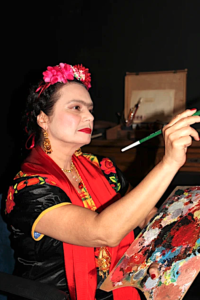
The play ends with Frida Kahlo’s increasing desire to leave this world and the pain of her wrecked body. Despite the fussiness of her nurse Judith and the assistance of a trusty servant Manolo (Francisco Medina), Diego is terrified of losing his life companion and deepest love Frida, so he takes the key to the medicine cabinet where Frida’s pain-killing drugs are stored. He fears that she is contemplating death too early and may overdose.
“Frida: Stroke of Passion” packs much of the love life of Frida Kahlo into this play and the many interesting figures in her life. Playwright Odalys Nanin has made her interpretation of Frida Kahlo come to life as a tortured creature with an unbounded imagination as mirrored in her famous paintings projected on the theatre walls. Diego Rivera was always the center of her life, despite her many loves. She was so tiny compared to this huge man with a face that reminded her of a frog. We are drawn into the beauty and pain of Frida Kahlo as she mirrored her existence on canvas.





